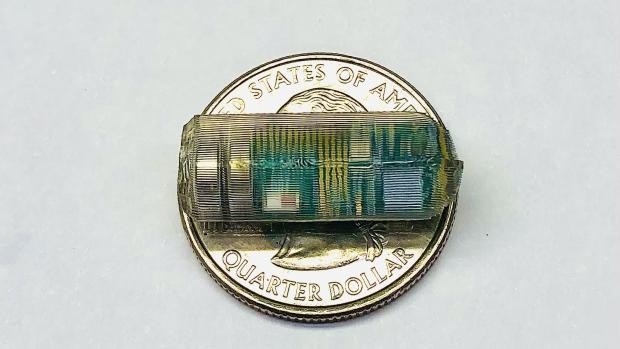What’s your gut telling you?
NYU Tandon School of Engineering’s Khalil Ramadi develops tiny ingestible device that promises to diagnose GI disorders without intrusive medical procedures

An ingestible electromagnetic device that could reveal the inner workings of the gastrointestinal tract on a coin for scale
BROOKLYN, New York, February 13, 2023 – Diarrhea. Constipation. Heartburn.
Millions of people suffer from these painfully common conditions and often endure inconvenient and invasive medical procedures to diagnose the causes.
That could soon change.
In a study published in Nature Electronics, Khalil B. Ramadi, Assistant Professor of Bioengineering at NYU Tandon School of Engineering, revealed that he and a team of collaborators at MIT and Caltech have developed a tiny pill-like electromagnetic device that, once swallowed, could provide medical professionals a diagnostic window into the inner workings of the gastrointestinal (GI) tract.
The bluetooth-enabled device delivers a continual stream of data to a smartphone as it passes through the subject, using electromagnetic technology similar to what makes Magnetic Resonance Imaging (MRI) machines work.
This breakthrough means that the more than one-third of the global population with irritable bowel syndrome and other disorders related to motility — the functioning of muscles and nerves in the GI tract — could avoid standard diagnostic procedures like computerized tomography (CT) scans, X-rays or endoscopic tubes inserted through the nose or other entry point. Those procedures can be physically and mentally uncomfortable, rely on potentially harmful radiation, and demand patients spend considerable time inside medical facilities.
Instead, the ingestible radiation-free microdevice would require only that people keep close to electromagnetic coils as the device makes its way through their bodies. The coils could be worn in a backpack or jacket, so patients could go about their normal lives during the process.
“We anticipate that our ingestible microdevice may keep people out of hospitals and reduce burdens on the healthcare system, while delivering information vital to diagnose motility disorders as accurately as possible,” said Ramadi, who heads the Laboratory for Advanced Neuroengineering and Translational Medicine at NYU Abu Dhabi.
Ramadi and his colleagues spent three years developing the device, which required creating a system of electromagnets that could function with high-resolution throughout the one-to-two foot range of the human abdomen, and not degrade in the GI tract. In the Nature Electronics paper, they announced their successful trial on pigs, suggesting the likelihood of similar results in human trials necessary for the device’s eventual real-world availability.
“Motility disorders and diseases involve the GI tract moving at abnormal speeds, including by working too quickly or slowly in specific places, but those things can be frustratingly difficult to measure,” said Ramadi. “Current ingestible trackers tell us conditions like temperature inside the body, or capture images, but don’t directly indicate their location. Once our highly-sensitive device is swallowed it also shows us exactly where it is at any time. That gives us a timeline of the tract’s movement and exposes the precise place of the malfunction, information critical to identifying the underlying disease.”
This new study adds to Ramadi’s track record in pioneering novel ingestibles that can diagnose and treat medical conditions. Previously, he announced that his team created an ingestible device that uses electrical signals to modulate brain activity via the gut, a development that could lead to treating a range of diseases, from Alzheimer’s to diabetes, without medications - and their attendant side effects – or surgery.
Ramadi’s work also exemplifies Tandon’s commitment to groundbreaking research that improves healthcare, one of the School’s areas of excellence. Among many other contributions to the field, Tandon researchers have recently created smartwatch-like devices that can help wearers manage their mental states; retina scanning that can predict stroke reoccurance; technology to help track the development of breast cancer; and models to assess the accuracy of mortality predictions when applied to different geographies.
As a lead author, Ramadi wrote the Nature Electronics paper together with Saransh Sharma, a graduate student at Caltech. Azita Emami, Giovanni Traverso, and Mikhail Shapiro are the senior authors of the study.
About the New York University Tandon School of Engineering
The NYU Tandon School of Engineering dates to 1854, the founding date for both the New York University School of Civil Engineering and Architecture and the Brooklyn Collegiate and Polytechnic Institute. A January 2014 merger created a comprehensive school of education and research in engineering and applied sciences as part of a global university, with close connections to engineering programs at NYU Abu Dhabi and NYU Shanghai. NYU Tandon is rooted in a vibrant tradition of entrepreneurship, intellectual curiosity, and innovative solutions to humanity’s most pressing global challenges. Research at Tandon focuses on vital intersections between communications/IT, cybersecurity, and data science/AI/robotics systems and tools and critical areas of society that they influence, including emerging media, health, sustainability, and urban living. We believe diversity is integral to excellence, and are creating a vibrant, inclusive, and equitable environment for all of our students, faculty and staff. For more information, visit engineering.nyu.edu.

